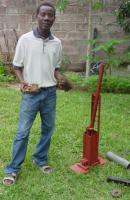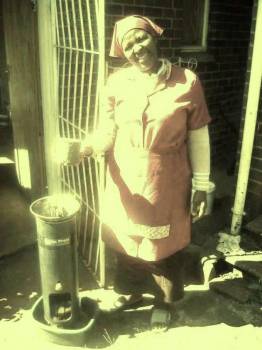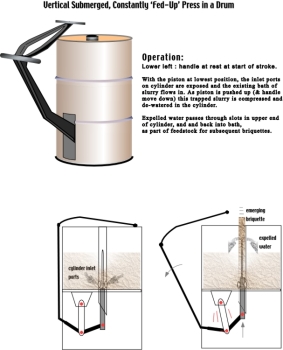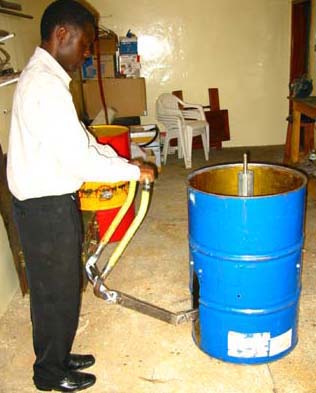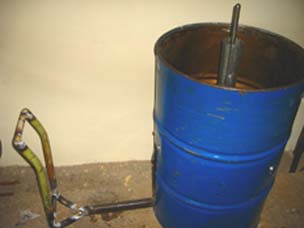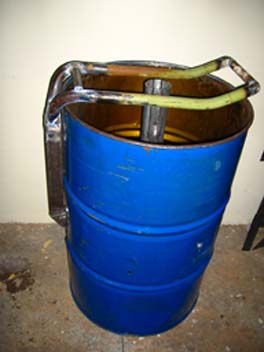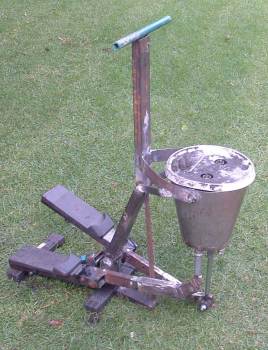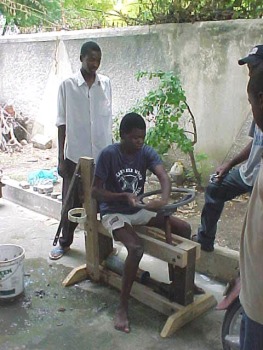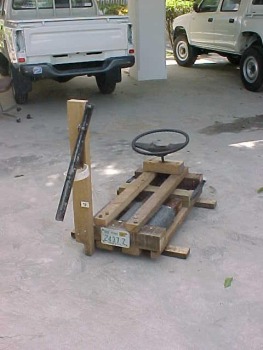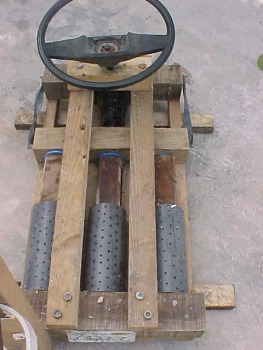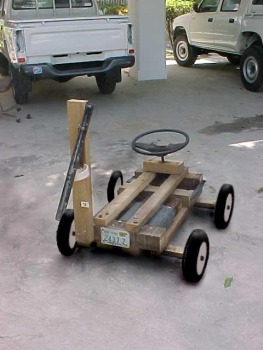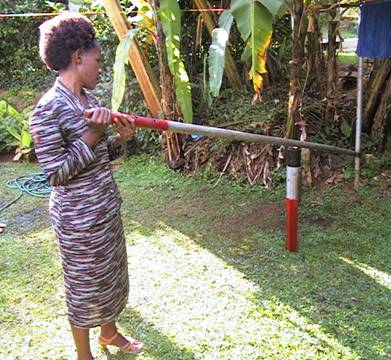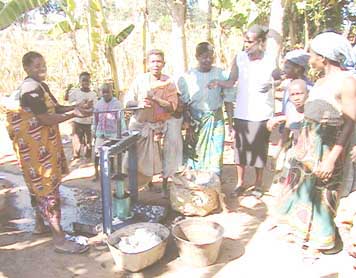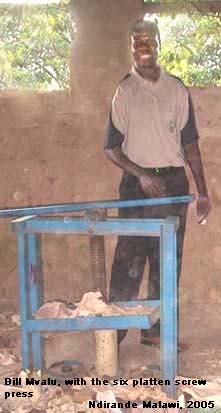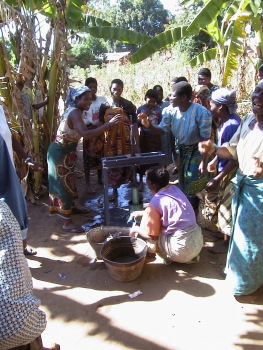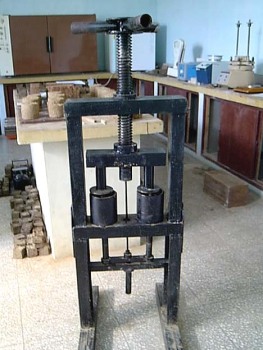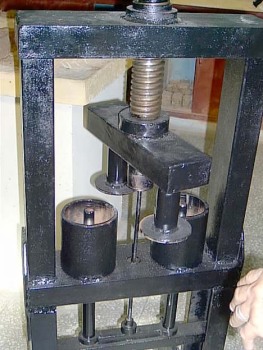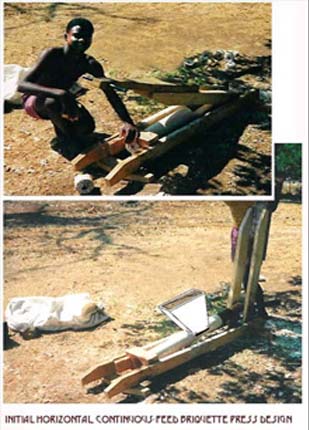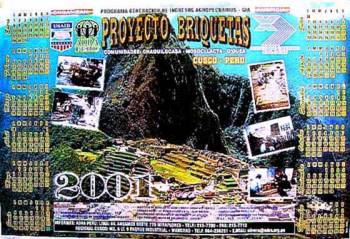From Richard Stanley Legacy Foundation
Subject: response to your report on Burkina Faso...
Richard:Steve,
This is in response to your email sent earlier, below in which several issues are presented.
Steve: We set out to build three pressed I had designed during our initial month of talks. We were grossly inefficient in spending, but we produced three presses to try out in three villages.
Richard:The press you designed is clever. Thought I'd share a few other designs with you too.
1) A hinged base with a miniature ladder arrangement, the rungs of which provide a multi position pivot for the lever, from Mozambique Keith and Alberto of the SPARK association outside Maputo: Shown is Alberto with bqs in hand lever leaning against cylinder. with mini ladder welded on ot top end of cylinder. I think it hinges at base to open for briquette release.
Contact: ketoooo@fastmail.fm
2. A series-loaded single lever press from Kathmandu Nepal's FoST organization headed by Sanu Kaji.
In this design up to four pre loaded cylinders are stacked on right in a solid bottomed feed tray. Operator presses out the left most cylinder over a corresponding hole in said feed tray. Empty cylinder is then reloaded and stacked in line from right. Contact; Sanu for more details at: fost@ntc.net.np
3. Our Porta Press developed in south africa, (its up on the website as well) for field demonstrations and training developed in South Africa. This is essentially the same down press ex lever but with an added outer shield, to contain the water....
4. Our fed up oil drum press...
¨
¨
5. Our other "fed Up" press was a two cylinder "Stepper press", so called because it was built up from a scrap stepper exercise machine. It was designed for small diameter briquette making more like 30 mm dia X 40--60 mm long pellets shown on top of the stainless steel pail's white plastic lid . As with the above oil drum design it holds great promise but it has not really been tested to a final design we can be confident in. As above anyone who wants to dive in and carry it fwd let us know: We will help you with as many fabrication and test experience details as we have, on the understanding that you will let us know how it works for you so that we can develop it too. You retain it for your own local production use and sale according to your own markets: We'll develop the full technical manual for it with reference to you and provide that over the net, as needed. No patents please.
6. The hinge press of Francis Oloo in Kangemi Kenya. This is a multi size batch fed design using tin cans and a clever banding mechanism, a couple of 2x6's and a hinge. Kinds like an oversized garlic press. You use your knees for pressure. Contact Francis Oloo or Charles Onyando for details: charlesonyando@yahoo.com I do not have his friend, and originator, Francis Oloo's email handy)
¨
7. in Haiti via the Actionell Fleurisma / World Concern organisation in Haiti: A hydraulic batch-fed single, then multi cylinder design and a revised go cart design...contact f.actionnel@caramail.com
8. The Poor One press out of Uganda (ours). Features a notched angle iron stand with hoop to hold cylinder (ex base)
for expelling the briquette. Lever is either wedged into a tree under a large rock or a bumper of an old vehicle.
See: The Poor One Press
9. The screw presses of PAMET and Nkhomano center in Malawi and Cuba. The blue colored smaller designs were made up by some engineering firm in Blantyre Malawi and are in daily use there for the past several years.
The taller (black metal) Cuba press was part of an engineering study in Germany by the professor Martirena from Cuba. We have little data on it. Contact the respective organisations for details:
William Malabu of the Nkhomano center nkhomano@sdnp.org.mw
Bonaventure Chidsaru of the Pamet organisation pamet@africa-online.net both in Malawi. at chiradzulu
Nuevo prensa by Prof. Martirena of the Ecosur organisation contact email: ecosur@ecosur.org
Ecosur http://www.ecosur.org/
See: EcoSur Solid Fuel Block SFB
10. Continuous feed design out of Malawi (produced a 2 meter long briquette for what its worth!) experimental only.
11. Perhaps the longest running press thru our initial outreach activities, in Kenya with the Wood family and with the Kangemi womens empowerment center and Charles Onyando and his colleague, with his innovative material chopper
From left, Mary Kavita, Alois (the carpenter), and Francis Kavita (holding handle) with Nick and father Christopher Wood (md) in Lengatta Kenya. Mary and Francis are spreading the word widely in Kenya, while and Nick and Chris supply presses and backstopping and awareness support nationwide.
12. The Kareni refugee camp in northern Thailand with David Saweh
13. Peru ADRA organisation extension efforts in Cusco departamente. The activity was then headed by Carlos Olivera and Pablo Arrujo of ADRA in LIMA.
14. And finally the jacked up press developed with the university of Southern Oregon's Chem department for testing thermal and emissions properties: screw jack used for forcing bq up into turret locked top. Twist it off and continue jacking to expell it. Recommend a hinge lock here not turret lock as latter takes too much vertical space.
Producing a viable mixture was the next problem. Our first co-authored
attempt was a failure, so we all set off to our own villages with a plan to test and re-test till we figured out what worked. A month or two later my technique and recipe became manageable.
70-75% leaves (mango, nim, eucalyptus etc...)
20-25% paper, and
5-10% various organic material (millet stalk, rice husk, etc).
This was then broken down in a standard medium sized mortar and pestle. I found letting the mixture marry in black plastic bags in the sun best for decomposition. I then would press them in the "eco-press" yielding 3-4 briquettes per press. normally 35-50 per bucket of mix.
The above single lever designs will work for paper blends but as you move away from paper, the ballgame changes. You find that you have to move to briquetting 202 (from 101) to get the stuff to hold together.
The business of not just chopping but defibrating and partial decomposition becomes lots more critical and is usually only well mastered by the rural farmers closest to the land--unless you do lots of training beforehand.
After attaining a workable mix that would burn from 25-40 minutes long. I began training other volunteers on the technique. At the same time I wrote a grant to the peace corps partnership asking for enough money to build 30 presses to be distributed to thirty different communities. All assisted by a trained PC volunteers. At this point,
each volunteer has identified a local group interested in the project and has received their press. They are now waiting for the dry season, which is beginning as I write this, to begin gathering leaves. The next step is to gather info from the thirty volunteers to find "best practices" in order to aid the communities that are struggling.
The whole notion of helping struggling communities is the heart and soul of our larger effort too. We approach it
with a bit of a hard nose, seeking to develop capacity for selling the product almost immediately to demonstrate its value and to demonstrate that it is a small business for serious self sustenance. We have been drawn into helping for environmental reasons only but have been repeatedly frustrated by the need of the participants for continued assistance.
I would frankly shoot for assuring Economic viability first but you are probably already thinking along these lines.
In my opinion, the next big step that could be made is to purchase regional grinders. I have already identified a welder who can make large scale grinders which could process a seasons worth of leaves in
a week. This grinder could then be sent to neighboring villages in order to reduce cost. This welder could produce each grinder for 100$US. It is the same welder who produced the original "eco-press" for a unit price of 30$US.
Be great to see the grinder you have in mind. We have developed a thresher Masher Chopper device coming up on our website in a few weeks) but we have also seen use of a mechanized hammer mill (frankly, a slightly sped-up 5 hp Sears and Roebuck yard chipper). There is an easily made modification to an ordinary lawnmower (posed by mother earth news http://www.motherearthnews.com/library/1984_March_April
The process of preparing materials is itself a spin off business and it will greatly reduce the overall cost of the briquette/ read profit of the briquette maker if all are fair in their pricing. If say 10 of your single lever press operators go together on one such 5 hp machine, they will very likely reduce their production costs by 30% (with your mentioned blends) to our experience but this of course depends upon local costs there for energy and spares etc... There is also a clever but dangerous design developed in Comitan Southern Mexico but I am hesitant to share it with you for your own safety !
I would love any input I could get on technique and I would be happy to share what I have found. I am quite pleased with my paper breakdown technique. I begin by ripping the paper into generous pieces. at this point it is not necessary to be too careful. 2-2.5 in squared will work. as I tear the paper I deposit in a bucket of water. When I am finished I squeeze out the excess water and place the ball i the mortar. I then pound it for a minute or too until it is dry. I then add small amounts of water to the paper as needed. it will quickly turn into a maché consistency. This technique cuts down highly on clumping that will not fully integrate into the leaves. The old technique was to place the paper periodically back into the water to rehydrate and it was quite inefficient both time-wise and for the quality.
Try adding grasses to the paper (and to other biomass as well, as these are a bit acid and tend to break it/them down quickly. If you are pounding materials by hand add some sawdust or woodchips as these too will tear it/them apart rapidly. Still, others have used warm water which also tends to break it/them down quickly. You could also just add water which has been soaked in wood ashes as this is a low grade form of caustic soda...but you'll have to wash your hands frequently ...
Well this has gone on far to long to ever reach most of you, so I'll stop for now
Lets stay in touch as needed and best of luck to you.
Richard Stanley
Legacy Foundation
http://www.legacyfound.org

